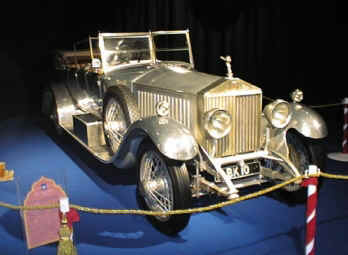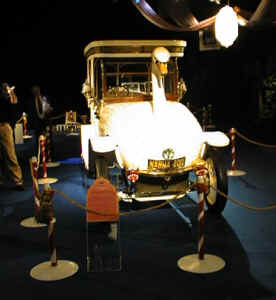
. . .
.. . . © 1998 - 2002 Copyright
& |
. When one rules supreme over millions of subjects, when one receives every year his weight in diamonds or gold, every eccentricity is permitted, including, of course, automobile fantasies. For some fifty years (till 1947), some six hundred Maharajas, Rajas, Nawabs and Nizams of India vied with each other in daring and extravagance with "this tool of modern civilization which passed over the poetry of Arabian Nights".
Maharajah Cars at the Geneva Autosalon 1999 Their thirst for prestige and fierce rivalry built up the success of prestigious car constructors such as Rolls-Royce, Bentley, Hispano-Suiza, Isotta-Fraschini etc. as well as of famous coachmakers of the Twenties and Thirties such as Barker, Wylder, Mulliner, Labourdette, Saoutchik, Castagna and many others. Witnessing their passion for utmost automobile, they left a rich inheritance. Eight unique cars were exhibited at the 1999 Geneva International Motorshow by AXA Assurances, the Swiss subsidiary of the insurance group AXA at the "AXA Fascination Cars" and featured superb examples of this glamorous era.
Photo: Automotive Intelligence Swan Car, 1912 Ex H.H. The Maharajah of Nabha Having an obsession with the swan, an English engineer in India imagined this extravagant body with the shape of the white bird embellished with Lotus flowers, a symbol of wisdom. Status SymbolAs colons drove through Bombay and Calcutta the first "horseless carriages", deed of British technology, Indian princes promptly identified the advantages they could get out of it. From a political standpoint, a self-propelled vehicle without horses, elephants nor oxen, impressed the people and reinforced their authority. With respect for sports, automobiles allowed for fast and comfortable journeys and were a distinctive asset for tiger hunting by night because of their headlights. In addition, the automobile brought a touch of modernity to a civilization rigidly set into outdated structures. However, a King’s automobile should not be compared to the common petrol vehicle used by colonial civil servants or administrators. It should celebrate the power and wealth of its Royal Owner, feature a status symbol. Mother-of-pearl clad dashboards, inlaid works using most precious woods, trims made of crocodile, ostrich hide or catpelt, golden or silver accessories, shinny bodies: with such wealthy and extravagant clients, coachmakers such as Barker, Wylder, Mulliner, Trupp & Maberly as well as Labourdette, Saoutchik or Castagna were allowed realizing everything they experimented in their imagination .. and even more. It happened a Maharajah to order a built-in bathtub or a raising seat allowing for shooting from his car.
Rolls-Royce Phantom Ordering only one car would have been trivial. Even the "Star of India", a Rolls-Royce Phantom II, "a goddess commanding admiration" according to the wish of the Maharajah of Rajkot. His peer, the Maharajah of Aiwar ordered together no less than six Hispano-Suiza for tiger hunting. Rolls-Royce, Bentley, Daimler, Lanchester, English manufacturers took the lion’s share in the Maharajah’s mechanical stables, but Hispano-Suiza, Isotta-Fraschini, Alfa-Romeo, Cadillac, Farman and Duesenberg also were praised because of their image of luxury and sport.
Photo: Automotive Intelligence The automobile golden era of the Maharajas came to an end with the independence of India in 1947. In order to rule a political jigsaw of some hundred kingdoms and principalities, the British Empire granted numerous privileges to the Maharajas. The Indian Republic proved to be far less generous: Maharajas, Rajas and Nizams had to give up political power, privileges and civil list. They had to declare their patrimony and pay taxes. They could forget about receiving every year their weight in diamonds or gold. This also was the end of automobile extravagances. Some Maharajas turned into car-collectors, such as the Prince of Gondal, a fine local driver, who bought from his peers many rare fine cars. Other ones, like the Aga Khan, migrated to Europe in order to pursue their passion for automobile. The most important car collection of India – some two hundred cars, most of them bought from the former kings and princes – is located in Malabar Hill, the elegant district of Bombay. Industrialist Pranial Boghilal plans an automobile museum, the jewel of which would be a Rolls-Royce Phantom III powered by a V-12 engine and featuring golden accessories, which formerly belonged to the Maharajah of Udaipur. The maharaja’s immoderation and eccentricities were irritating but nevertheless they gave many coachmakers the opportunity to express their creativity. Automobile needs sponsors to be something more than a bare functional tool of our mobility.
[Homepage] [ News] [ Companies] [ Management] [ Publications] [ Events] [Careers] [Services] [Discussion] [ Guestbook] [ Search] |



